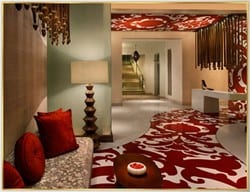 Photography courtesy of Kaya Kalp
Photography courtesy of Kaya Kalp
Tales of the great Mughal Empire tell of princesses bathing in lavish suites where milk, honey, and rose water poured freely amidst fully heated hammams where water flowed endlessly despite its scarcity. Gardens laden with exotic flowers sat amid streams and fountains—a remarkable feat in the arid landscape of modern day Utar Pradesh. It is this heavenly world that architect Pradeep Sachdeva and Bangkok-based P49 Deesign sought to conjure in their design for the Indian state’s latest (and largest) experience spa—Kaya Kalp, the Royal Spa at the ITC Mughal, a Starwood Luxury Collection hotel in Agra, the capital of the Mughal emperors from 1526 to 1658.
For the architectural design, Sachdeva took cues from the spa’s breathtaking surroundings: the awe-inspiring Taj Mahal, historical city Fatehpur Sikri, and countless other resplendent remnants of the Mughal. "These [landmarks] have been an inspiration for the somewhat humbler, in comparison, scale of [Kaya Kalp]. The key was to be able to draw inspiration from the attention to detail which these landmarks have—a contemporary interpretation of the architectural spirit of Agra," says New Delhi-based Sachdeva.
 A decidedly contemporary reinterpretation of Mughal architecture, the spa complex utilizes handcrafted techniques and elaborate details in stone latticework, brick, sumptuous fabrics, and water features that employ the plant-inspired decorative patterns used in Mughal architecture. "The main concept element was the four precious jewels that, in mythology symbolize four characters; the ruby is related to space, the pearl to energy, gold to flow, and platinum to bliss," explains Chakkraphong Manipanti, P49 Deesign’s partner and project leader in describing his interior material choices. A stylized pomegranate motif in laser-cut ruby red imitation marble inlaid with white-cast terrazzo presides over the reception floor and flows throughout the space. This refers to a classic Mughal motif (it’s the empire’s signature fruit), but with a contemporary twist, and as Manipanti explains, offers a "sense of prevailing exotic arrival." Elsewhere, antique brass, mother of pearl, mirrored mosaics, Agra pale gray stone, and dark oak wood, velvets, and shimmery curtains help to further the regal feel.
A decidedly contemporary reinterpretation of Mughal architecture, the spa complex utilizes handcrafted techniques and elaborate details in stone latticework, brick, sumptuous fabrics, and water features that employ the plant-inspired decorative patterns used in Mughal architecture. "The main concept element was the four precious jewels that, in mythology symbolize four characters; the ruby is related to space, the pearl to energy, gold to flow, and platinum to bliss," explains Chakkraphong Manipanti, P49 Deesign’s partner and project leader in describing his interior material choices. A stylized pomegranate motif in laser-cut ruby red imitation marble inlaid with white-cast terrazzo presides over the reception floor and flows throughout the space. This refers to a classic Mughal motif (it’s the empire’s signature fruit), but with a contemporary twist, and as Manipanti explains, offers a "sense of prevailing exotic arrival." Elsewhere, antique brass, mother of pearl, mirrored mosaics, Agra pale gray stone, and dark oak wood, velvets, and shimmery curtains help to further the regal feel.
 And since this was the first spa brand of the ITC Group (with two city spas following soon after), Manipanti had to make sure that the spa had a strong identity. "Established as a roadmap for the brand, Kaya Kalp was more extravagant and ornate with a feminine touch, plus the feeling of a destination spa," he says. Another challenge of the project? Making a connection between the building and its extensive gardens. "Plant selection was done on the basis of historical references and is the reason for the extensive use of the pomegranate motif throughout the spa," says Sachdeva.
And since this was the first spa brand of the ITC Group (with two city spas following soon after), Manipanti had to make sure that the spa had a strong identity. "Established as a roadmap for the brand, Kaya Kalp was more extravagant and ornate with a feminine touch, plus the feeling of a destination spa," he says. Another challenge of the project? Making a connection between the building and its extensive gardens. "Plant selection was done on the basis of historical references and is the reason for the extensive use of the pomegranate motif throughout the spa," says Sachdeva.
Kaya Kalp — The Royal Spa
Hotel Mughal, Agra, India
 Owner and Purchasing Firm: ITC Hotels Limited
Owner and Purchasing Firm: ITC Hotels Limited
Spa Operator: Spa Synergy
Architecture Firm: Pradeep Sachdeva Design Associates, New Delhi
Architecture Project Team: Pradeep Sachdeva, principal architect; Madhu Shankar, Vidya Tongbram, Namrata Mehra, and Raj Dilip Dorai, coordinating architects
Interior Design Firm: P49 Deesign and Associates Co., LTD, Bangkok
Contractors: Prime Engineers (civil) and Aadharshila (interiors)
Lighting: Integrated Lighting Design
Engineering: Spectral Services
Landscape: Pradeep Sachdeva Design Associates
Furniture: Custom by P49 Deesign
Decorative Lighting Supplier: Kapoor Enterprises
Artwork: Manglam Jaipur and Picturesque, Delhi
Fabric: Muslin


